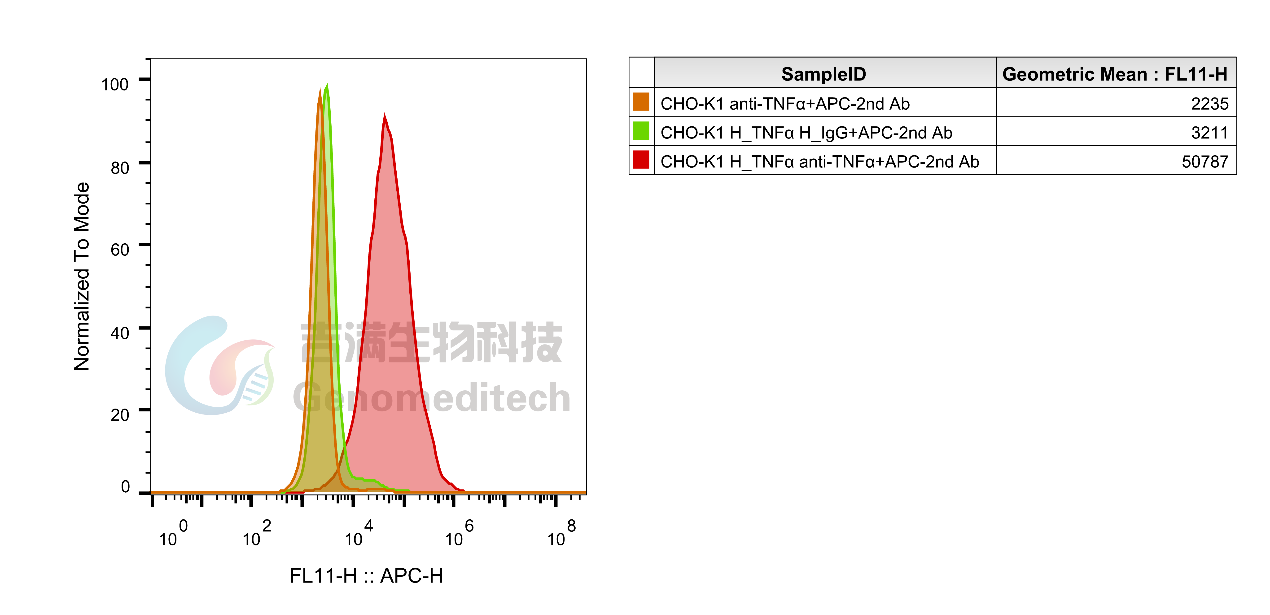Cat. No:GM-49267AB
Product:Anti-TNF-α hIgG1 Antibody(CT-P17)
Cat. No:GM-49267AB
Product:Anti-TNF-α hIgG1 Antibody(CT-P17)
GM-49267AB-10 10 μg
GM-49267AB-100 100 μg
GM-49267AB-1000 1 mg
Species Reactivity Human
Clone CT-P17
Source/Isotype Monoclonal Human IgG1,κ
Application Block assay
Specificity Detects TNF-α.
Gene TNF-α
Other Names DIF; TNFA; TNFSF2; TNLG1F
Gene ID 7124
Background TNFα is expressed as a type II membrane protein attached by a signal anchor transmembrane domain in the propeptide, and is processed by a matrix metallo-proteinase, termed TNFα-converting enzyme (TACE). TNF is predominantly produced by macrophages, but can also be secreted in limited quantities by B cells, natural killer cells, endothelial and muscle cells, fibroblasts, and osteoclasts. TNF exists in a membrane-bound and a soluble form. During synthesis, TNF translocates to the cell membrane where the TNF-converting enzyme releases the membrane-bound 26 kDa molecule into the extracellular milieu as a 17 kDa protein. The activity of this enzyme not only releases TNF from the plasma membrane, but also cleaves TNF receptors off the surface, which act as an inhibitor of TNF action. Both membrane-bound and released TNF are active.
Storage Store at 2-8℃ short term (1-2 weeks).Store at ≤ -20℃ long term. Avoid repeated freeze-thaw.
Formulation Phosphate-buffered solution, pH 7.2.
Endotoxin < 1 EU/mg, determined by LAL gel clotting assay

Cat. No:GM-49267AB
Product:Anti-TNF-α hIgG1 Antibody(CT-P17)
GM-49267AB-10 10 μg
GM-49267AB-100 100 μg
GM-49267AB-1000 1 mg
Species Reactivity Human
Clone CT-P17
Source/Isotype Monoclonal Human IgG1,κ
Application Block assay
Specificity Detects TNF-α.
Gene TNF-α
Other Names DIF; TNFA; TNFSF2; TNLG1F
Gene ID 7124
Background TNFα is expressed as a type II membrane protein attached by a signal anchor transmembrane domain in the propeptide, and is processed by a matrix metallo-proteinase, termed TNFα-converting enzyme (TACE). TNF is predominantly produced by macrophages, but can also be secreted in limited quantities by B cells, natural killer cells, endothelial and muscle cells, fibroblasts, and osteoclasts. TNF exists in a membrane-bound and a soluble form. During synthesis, TNF translocates to the cell membrane where the TNF-converting enzyme releases the membrane-bound 26 kDa molecule into the extracellular milieu as a 17 kDa protein. The activity of this enzyme not only releases TNF from the plasma membrane, but also cleaves TNF receptors off the surface, which act as an inhibitor of TNF action. Both membrane-bound and released TNF are active.
Storage Store at 2-8℃ short term (1-2 weeks).Store at ≤ -20℃ long term. Avoid repeated freeze-thaw.
Formulation Phosphate-buffered solution, pH 7.2.
Endotoxin < 1 EU/mg, determined by LAL gel clotting assay
